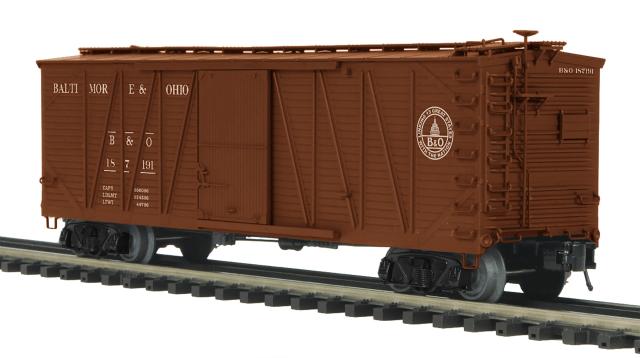
August 3, 2021 - M.T.H. Electric Trains will be releasing several limited-edition releases of the Premier 40’ USRA Single Sheathed Boxcar in four different, unique liveries. The cars will be available in two different car numbers and will begin arriving on M.T.H. Authorized Retailer shelves in December 2021.
At midnight on Monday, December 31, 1917, the federal government took control of the U.S. railroad system. Acting under wartime powers granted to him by congress, President Woodrow Wilson had nationalized the railroads when they proved unequal to the task of moving massive amounts of men and materiel for the Great War in Europe. Although hostilities would end in 11 months, government control would last until 1920. The agency that ran the trains was the United States Railroad Administration, or USRA, and one of its chief accomplishments was the building of nearly 100,000 freight cars of five standard designs, to relieve equipment shortages.
What would become the car committee of the USRA had actually started its work in the summer of 1917. Appointed by the Council of National Defense, the committee members were high-ranking executives from Baldwin Locomotive Works, American Car & Foundry, Pullman, and other car builders. Because they had a head start, their finalized car designs were ready within three months of the government takeover. The five body types eventually produced in quantity were a 50-ton steel frame single-sheathed box car, a 40-ton steel frame double-sheathed box car, a 55-ton steel 2-bay hopper, a 50-ton composite drop-bottom gondola, and a 70-ton steel mill gondola.
The twin box car designs reflected the car committee’s indecision about which design was actually superior, as well as the perception that splitting production between the two types would speed wartime delivery. The use of wooden sides with steel underframe, ends, side framing and roofs reflected common practice of the time, when the steel car era was not yet in full swing. A wartime shortage of plate steel was also an important consideration.
The double-sheathed car had a heavy fishbelly underframe and steel side framing sandwiched between vertically paneled inner and outer wood walls. The single sheathed design had a straight center sill, exposed steel framing, and a side wall built of 18’ lengths of lumber that were more expensive and harder to obtain than the lumber for double-sheathed cars. The single-sheathed cars, however, were lighter and easier to maintain. The original wartime order was for 25,000 of each type, allocated among 60 railroads.
In the end, however, very few cars were delivered before war’s end, and a good deal of wrangling ensued over the final car allocations. By the time the last cars were delivered in 1920, 25,000 single-sheathed cars had been accepted by 22 railroads and 24,500 of the double-sheathed design by 24 railroads. Very few roads rostered both types. The USRA designs proved durable enough that many cars served through the next World War and years beyond, rolling alongside their newer all-steel brethren.
Our accurate, beautifully detailed model of the USRA single-sheathed car features simulated wood grain on the car sides and doors, see-through wood-grained roof walk, detailed brake system on the B end and underframe, metal corner steps, opening doors, and separately applied metal grab irons on the sides, ends, doors and roof walk.
Check out each of the schemes in the list on the left.




